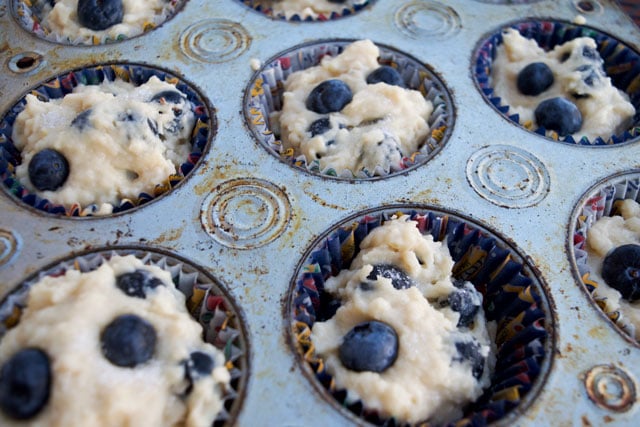Updated 6/18/24
What’s your Mother’s Day tradition? We know many families out there might start mom’s day off with breakfast in bed served by the kiddos or perhaps a special brunch. Let us help you bake up a special day for the moms in your life! We’ve got a wonderful kid-cook-friendly muffin recipe to share. It serves up some blueberry goodness and some learning too.
Baking has many easy STEM connections that can benefit a child well beyond breakfast. It allows you to put real-world concepts and STEM subjects into action – yep, math and science are whisked right into the fun. Plus, getting to eat your work never hurts, either! ;)

5 Ways Baking Benefits Your Child’s STEM Education
- Understanding Processes and Organization – A recipe is nothing more than a material list and instructions, not unlike what you might need for a science project or building project. Recipes allow kids to practice their reading skills and learn to follow step-by-step processes. Baking can also help kids understand basic organization through mise en place, which enables them to more efficiently and effectively prepare their items. Mise en place is a French term meaning “everything in its place” or “put in place” and is a foundational technique for cooking.
- Practicing Critical Thinking and Problem Solving – Baking is both an art and a science. To get consistent, predictable results relies on many factors and some practice. There are always many opportunities to think critically and solve problems in the kitchen. For example: When the bread doesn’t rise, you must consider what factors led to the undesirable product. Or how do you plan out your cooking time to accommodate each recipe's cooking time and temperature? Or, what can you substitute when you want to bake chocolate chip cookies and you’re out of brown sugar? These skills are hallmarks for success in project-based learning.
- Inspiring Creativity and Experimentation – Getting kids in the kitchen gives them a creative outlet and a chance to experiment with new equipment and ingredients and use their hands and minds to create a tangible, shareable product. Baking also allows the baker to customize the recipe to his or her own preferences. Adding constraints such as limited ingredients or tools and time is also a way to challenge experimentation. STEM fields inherently require curiosity and the ability to be purposefully innovative.
-
Gaining Practice with Concepts such as Measurement, Time, Temperature, Structure, Chemical/Physical Reactions – These concepts are present in many real-world STEM applications as well STEM lessons within the academic setting. Seeing these concepts in a relatable space can allow a child to more readily connect with the material and better apply it later.
- Measurement: Being able to accurately measure ingredients is critical to the baking process. Understanding conversions, weights, and volume are inherent to success with recipes.
- Time: Baking is the result of preparation and cooking time. Using a timer and/or practicing time-telling skills are necessary to properly prepare a recipe and get the desired result.
- Temperature: Selecting the right temperature, or maintaining a proper temperature, is a step in every baking project.
- Structure and Textures: Chewy pizza crust, tender muffins, dense cake, crispy cookies . . . all common descriptions for baked goods. Deciphering if your cake is solid enough to build a tiered layer cake or if your muffins have the proper crumb give a nod to understanding whether the baked good you created has the properties it needs to fulfill expectations.
- Chemical/Physical Reactions: Leavening is a basic baking concept that can be done via physical, chemical, or biological means. Many baking recipes require some type of leavener; without them, we’d have flat and dense sweets and treats.
- Collaboration and Patience – Baking is project-based learning at its finest. While baking can be a solo or group project, for kids, it’s a great opportunity to work together with a parent, sibling, cousin, or friend. Completing the task requires collaboration with your baking partners – allocating tasks and sharing the work as well as the credit. Baking also isn’t something you can rush along. You have to follow the process (see Point 1 again!) and wait the right amount of time for the item to bake. It takes patience, which is a soft skill that is necessary in work and play throughout life.
Bottom line: A child who is confident in the kitchen can be confident in the real world. Exposure to baking and cooking helps foster lifelong skills that will serve them well in STEM-based projects and careers. Plus, he or she won’t go hungry!

[RECIPE] Mother’s Day Blueberry Muffins
Original recipe from Iwashyoudry.com.
Slightly Modified by Pitsco
INGREDIENTS
- 2 cups flour
- 1/3 to 1/2 cup sugar (you decide the sweetness you want!)
- 3 teaspoons baking powder
- 1/2 teaspoon salt
- 1 cup fresh blueberries (~3.5 ounces)
- 1 cup milk
- 1/3 cup salted butter, melted
- 1 teaspoon vanilla
- 1 egg, beaten
- Additional sugar for topping
INSTRUCTIONS
- Preheat oven to 400º F.
- Mix flour, sugar, baking powder, salt, and blueberries in a medium bowl.
- Add milk, melted butter, vanilla, and egg to the dry ingredients.
- Mix together with a fork until just combined. (All ingredients are incorporated/wet.) Be careful not to overmix; the batter will be thick.
- Place muffin liners into 12-count tin. Spray muffin tin liners with cooking spray (just a light spray). Fill with batter; sprinkle with additional sugar.
- Bake for 20 to 25 minutes.
Modification note: For even more flavor, add a bit of freshly zested lemon to the batter prior to mixing.
MORE RESOURCES:

